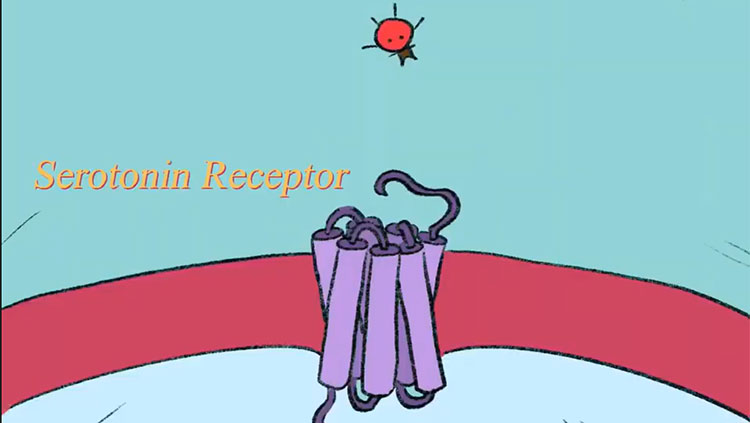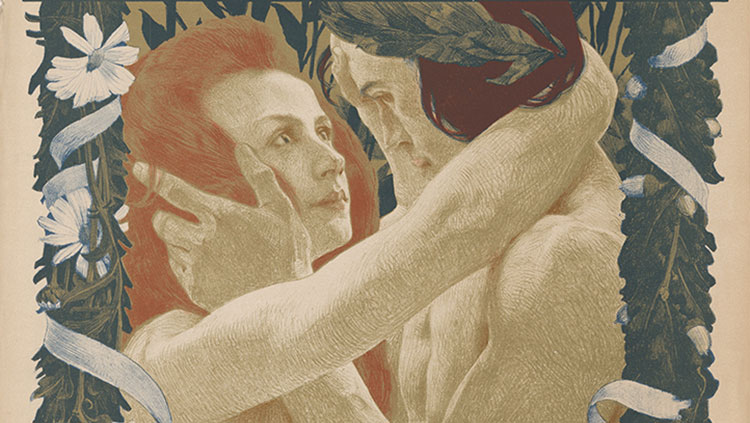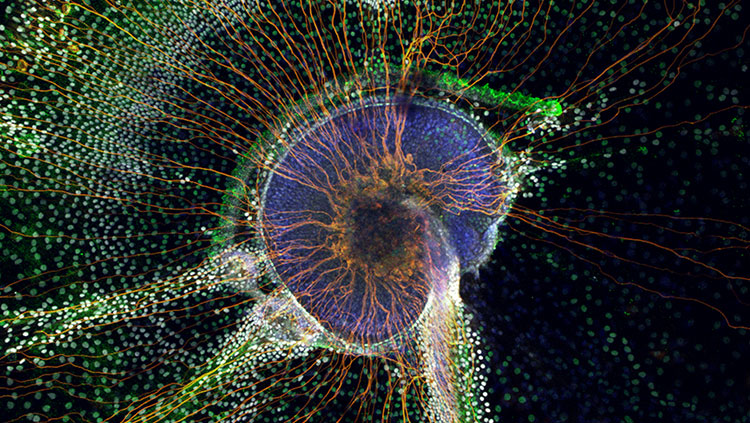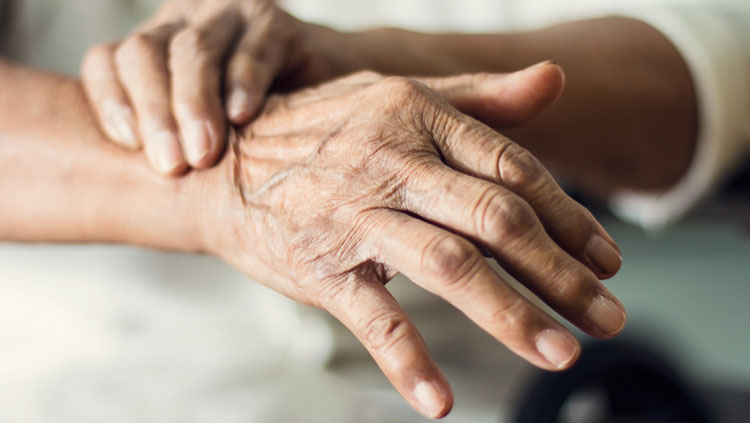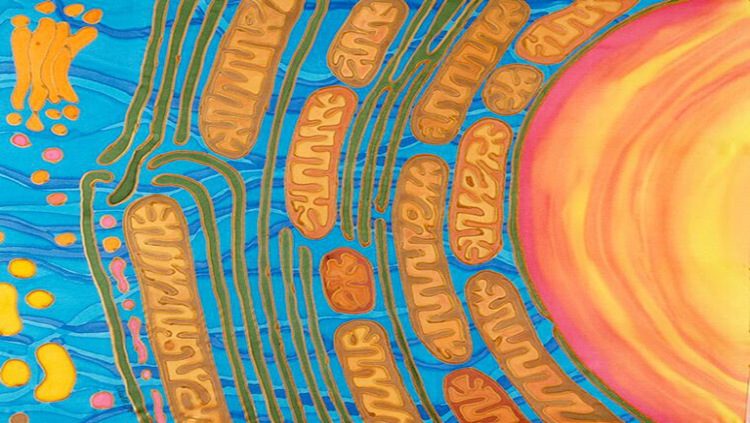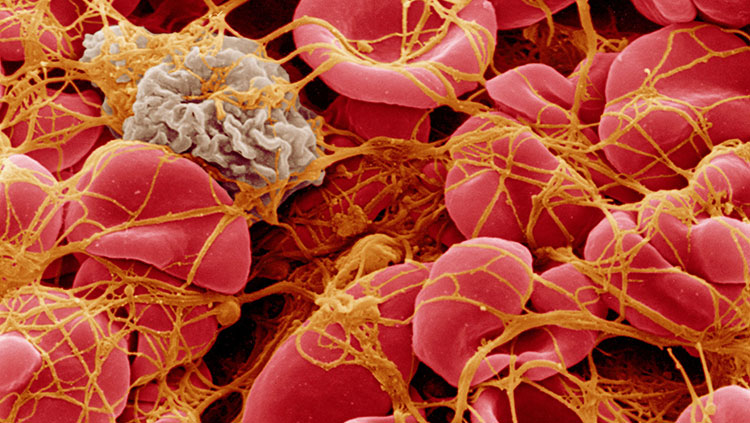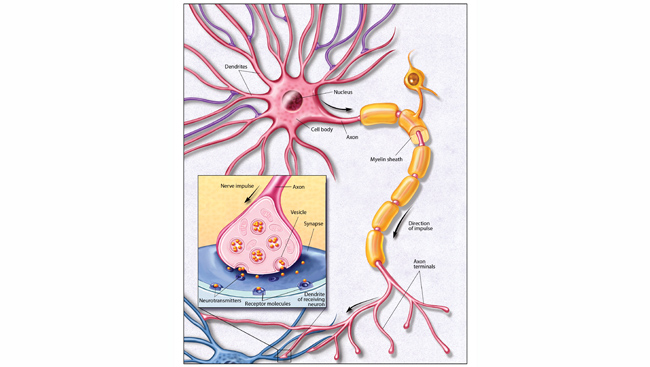Twin Studies: Histories and Discoveries in Neuroscience
- Published12 Jun 2019
- Author Katie Scarlett Brandt
- Source BrainFacts/SfN

Space travel changes the human body, but not so permanently that it can’t withstand long trips in space. That’s the conclusion NASA came to after Scott Kelly returned from 340 days aboard the International Space Station.
Kelly’s time in space changed the shape of his eyes, altered his gut bacteria, placed his immune system on high alert, and shifted the activity of his genes, among other things. But his body mostly returned to normal after his return from space. NASA knows this because Scott Kelly is a twin. And his twin, Mark Kelly, is a former astronaut who spent those same 340 days on Earth, providing a perfect comparison for how the body handles space.
While Scott and Mark Kelly may represent the most exotic comparison between twins to date, for over a century twins have been helping researchers understand how our genes and environment influence our susceptibility to disease. And, the value of that research is only increasing.
“Most twins love being in research, particularly identical twins. They feel like they really have something to contribute,” says Nancy L. Segal, director and founder of the Twin Studies Center at California State University, Fullerton.
Segal, a fraternal twin herself, turned her lifelong fascination in the marked differences between herself and her sister, now a lawyer, into a career exploring how genetics and environment intertwine to create each human’s experience.
In 1875, before scientists understood why some sets of twins appeared more similar than others, Sir Francis Galton — a scientist, statistician, and half-cousin of Charles Darwin — published the first twin study. In “The History of Twins”, Galton reported on the results of a questionnaire he’d given to families of twins. In it, he asked if the twins became more or less similar as they aged, irrespective of whether they were raised together or apart. Galton was trying to sort out whether a person’s nature, or genetics, played a greater role in who they became than the nurturing, or environment, they experienced.
Galton ultimately determined that “there is no escape from the conclusion that nature prevails enormously over nurture.” His resolute belief in the importance of heredity led him in 1883 to invent the term “eugenics” — a set of beliefs and practices aimed at increasing “desirable” human traits while decreasing “undesirable” ones. Perhaps well-intentioned, the science lacked rigor and the philosophy was used to propagate concepts of racial and class superiority.
Galton’s contribution to twin studies, however, remains to this day and has spawned an important field of study. Data from twin registries around the world help researchers answer a host of questions. Founded in 1959, the Swedish Twin Registry at the Karolinska Institute in Stockholm contains information on 194,000 twins born since 1886. The largest twin registry in the world, researchers have employed it to make important discoveries associated with cardiovascular disease, cancer, and aging. The TwinsUK Registry, which launched a database for studying arthritis, includes more than 14,000 twins, aged 16 to 100 years, from across the United Kingdom.
Twin studies matter because we need to understand what influences our development.Twin studies compare two different types of twins: identical and fraternal. Identical twins possess the same set of genes entirely, while fraternal twins share about half of the same genes, on average — similar to siblings who didn’t share a womb. This difference enables scientists to explore how heredity contributes to illness and behavior. For example, if identical twins are both more likely to suffer from high or low cholesterol levels than fraternal twins, researchers can conclude that genes play an important role in the development of that trait. From there, they can search for any associated genes.
“Twin studies matter because we need to understand what influences our development. Behavior? Physical structure? Twin studies are perfectly poised to teach us that,” Segal says.
Into the 20th Century
In 1979, Thomas J. Bouchard, Jr., Segal’s post-doctoral advisor and now colleague, posed a simple question: Were twins separated in infancy and raised apart less similar than those raised in the same family? In other words, to what extent were the cognitive and psychological differences between people the result of nature and nurture? To answer the question, Bouchard, a psychologist at the University of Minnesota and ultimately the director of the Minnesota Center for Twin and Adoption Research, and his team launched what became a landmark twin investigation: The Minnesota Study of Twins Reared Apart.
The study included more than 137 pairs of separated identical and fraternal twins and triplets from around the world who participated in a battery of medical and psychological tests. Over the years, Bouchard reported that identical twins reared apart developed personalities and interests that showed about the same degree of resemblance as identical twins who were raised together. For example, one set of twins who had been separated at four weeks of age learned as adults that each had pursued law-enforcement training, performed better in math than in spelling, and suffered from tension headaches beginning at age 18. Much more about the origins, methods, findings, and implications of this study are available in Segal’s 2012 book, Born Together-Reared Apart.
What We’ve Learned
With robust databases, researchers around the world have employed twin studies to publish hundreds of papers on blood pressure and heart disease, kidney disease, diabetes, the gut microbiome, fatigue, rheumatic diseases, aging, cancer, and periodontal disease — just to name a few. In addition, researchers have used advanced imaging among twins to predict brain age, found links between solvents and Parkinson disease risk, and identified genes associated with depression.
“The value of twins to neuroscience is increasingly appreciated,” says William Iacono, a psychologist at the University of Minnesota and co-director of the Minnesota Center for Twin and Family Research, whose graduate advisor told him any study would be inherently more interesting if it included twins.
For example, one of his studies used twins to answer the question whether adolescent marijuana causes IQ to decrease or are adolescents prone to smoking marijuana also pre-disposed to seeing their IQ’s drop regardless. The researchers looked at twins where one twin used the drug and the other did not.
The researchers found that when IQ dropped in the marijuana using twin, it also dropped in the twin who didn’t use the drug. In other words, the IQ drop was the result of a vulnerability that was present before any exposure to the effects of marijuana. These types of findings make twin studies especially important in neuroscience.
“We wouldn’t be able to pinpoint causality without the use of these twins,” says Iacono. “That’s the element that the twin component brings to the table and why twins are important to the [research] design.”
The 21st Century & Beyond
Twins research is playing a critical role in the Adolescent Brain Cognitive Development (ABCD) study — the largest long-term study of brain development and child health in the United States. Funded by the National Institutes of Health, the 21 center, 10-year study has enrolled nearly 12,000 children ages nine to 10, including roughly 1,000 twin pairs.
Such a large study offers new opportunities in neuroscience research. “Ten years ago, it was common to report findings on only 10 people,” says Iacono. “We need larger samples in order to get reliable findings, and we can use these data for targeted hypotheses to help us understand the genetic basis of brain development.”
Iacono and his colleague, psychologist Monica Luciana, are leading the University of Minnesota effort, which is one of four centers with a special focus on twins. All participants in ABCD will have MRI scans, annual assessments, and behavioral testing. Twins will provide crucial clues to the genetics at play in development and vulnerability to substance misuse.
“We're able to assess kids’ behaviors, brain structure, and function before they have initiated risk-taking behaviors, such as substance use,” Luciana says. “A weakness of other studies is the inability to distinguish trait-based genetic vulnerabilities from environmental substance-based effects. With continued funding, we can follow these children well into adulthood to answer such questions.”
CONTENT PROVIDED BY
BrainFacts/SfN
Discussion Questions
- Why are twin studies important to research on diseases and disorders?
- What conclusion were neuroscientists able to draw from twin studies?
- How do large studies and databases contribute to neuroscience research?
References
About the Study. (n.d.). Adolescent Brain Cognitive Development Study. Retrieved from https://abcdstudy.org/about/
Adolescent Brain Cognitive Development (ABCD) Study. (n.d.). NIH. Retrieved from https://www.nimh.nih.gov/research-priorities/research-initiatives/adolescent-brain-cognitive-development-abcd-study.shtml
Bouchard, T., Lykken, D., McGue, M., Segal, N., & Tellegen, A. (1990). Sources of human psychological differences: the Minnesota Study of Twins Reared Apart. Science, 250(4978), 223.
doi: 10.1126/science.2218526
Cole, J. H., Poudel, R. P. K., Tsagkrasoulis, D., Caan, M. W. A., Steves, C., Spector, T. D., & Montana, G. (2017). Predicting brain age with deep learning from raw imaging data results in a reliable and heritable biomarker. NeuroImage, 163, 115–124. doi: 10.1016/j.neuroimage.2017.07.059
Gialluisi, A., Visconti, A., Willcutt, E. G., Smith, S. D., Pennington, B. F., Falchi, M., … Fisher, S. E. (2016). Investigating the effects of copy number variants on reading and language performance. Journal of Neurodevelopmental Disorders, 8, 17–17. doi: 10.1186/s11689-016-9147-8
Gormley, P., Anttila, V., Winsvold, B. S., Palta, P., Esko, T., Pers, T. H., … Palotie, A. (2016). Meta-analysis of 375,000 individuals identifies 38 susceptibility loci for migraine. Nature Genetics, 48(8), 856–866. doi: 10.1038/ng.3598
Iacono, W. G., Heath, A. C., Hewitt, J. K., Neale, M. C., Banich, M. T., Luciana, M. M., … Bjork, J. M. (2018). The utility of twins in developmental cognitive neuroscience research: How twins strengthen the ABCD research design. The Adolescent Brain Cognitive Development (ABCD) Consortium: Rationale, Aims, and Assessment Strategy, 32, 30–42. doi: 10.1016/j.dcn.2017.09.001
Jackson, N. J., Isen, J. D., Khoddam, R., Irons, D., Tuvblad, C., Iacono, W. G., … Baker, L. A. (2016). Impact of adolescent marijuana use on intelligence: Results from two longitudinal twin studies. Proceedings of the National Academy of Sciences of the United States of America, 113(5), E500–E508. doi: 10.1073/pnas.1516648113
Jansen, A. G., Mous, S. E., White, T., Posthuma, D., & Polderman, T. J. (2015). What twin studies tell us about the heritability of brain development, morphology, and function: a review. Neuropsychology review, 25(1), 27–46. doi:10.1007/s11065-015-9278-9
Karon, A. (2014). Twin Study Confirms Genetic Basis of Several Epilepsy Syndromes. Neurology Reviews, 22(10), 8. Retrieved from https://www.mdedge.com/neurology/article/87535/epilepsy-seizures/twin-study-confirms-genetic-basis-several-epilepsy
Lmunoz. (2017, March 28). Twins Illuminate Genetic Influences on Brain Structure. Cognitive Neuroscience Society. Retrieved from https://www.cogneurosociety.org/twins-illuminate-genetic-influences-on-brain-structure/
Mars, K. (2015, April 14). Twins Study. NASA. Retrieved from https://www.nasa.gov/twins-study
Masi, S., Georgiopoulos, G., Ribero, S., Taddei, S., Bataille, V., & Steves, C. J. (2018). The relationship between naevus count, memory function and telomere length in the Twins UK cohort. Pigment Cell & Melanoma Research, 31(6), 720–724. doi: 10.1111/pcmr.12722
Norrgard, K. (2008) Human testing, the eugenics movement, and IRBs. Nature Education 1(1):170 Retrieved from https://www.nature.com/scitable/topicpage/human-testing-the-eugenics-movement-and-irbs-724
Okbay, A., Baselmans, B. M. L., De Neve, J.-E., Turley, P., Nivard, M. G., Fontana, M. A., … Cesarini, D. (2016). Genetic variants associated with subjective well-being, depressive symptoms, and neuroticism identified through genome-wide analyses. Nature Genetics, 48, 624-633.
doi: https://doi.org/10.1038/ng.3552
Other Twin Research at the U of M. Minnesota Study of Twins Reared Apart. Minnesota Center for Twin & Family Research. Retrieved from https://mctfr.psych.umn.edu/research/UM%20research.html
Pedersen, N. L., Lichtenstein, P., & Svedberg, P. (2002). The Swedish Twin Registry in the Third Millennium. Twin Research, 5(05), 427–432. doi:10.1375/twin.5.5.427
Samson, K. (2011). Study in Twins Suggests Solvents May Raise Parkinson Disease Risk. Neurology Today, 11(23) 1–17. doi: 10.1097/01.NT.0000410070.44352.53
Segal, N. L. (Ed.). (2017). Twin Mythconceptions. London: Academic Press. doi: 10.1016/B978-0-12-803994-6.00020-2
Society for Neuroscience. (2007, December 22). Twin Study Indicates Genetic Basis For Processing Faces, Places. ScienceDaily. Retrieved October 20, 2018 from www.sciencedaily.com/releases/2007/12/071218192044.htm
Sonnebring, G. (n.d.). Our Projects. Swedish Twins Registry. Karolinska Institute. Retrieved from https://ki.se/en/research/our-projects
Than, K. (2016, March 04). A Brief History of Twin Studies. Smithsonian Magazine. Smithsonian.com. Retrieved from https://www.smithsonianmag.com/science-nature/brief-history-twin-studies-180958281/
University of Minnesota. ABCD Study at the University of Minnesota. Retrieved from https://abcdstudy.org/study-sites/uminn/
W2 – Dyslexia and the Brain: Understanding the Neuroscience of Reading Development and Disability. International Dyslexia Association. Retrieved from https://dyslexiaida.org/w2/
Waller, J. C. (2012). Commentary: The birth of the twin study—a commentary on Francis Galton’s ‘The History of Twins.’ International Journal of Epidemiology, 41(4), 913–917. doi: 10.1093/ije/dys100
What is TwinsUK? - About Us. (n.d.). TwinsUK Registry. Retrieved from http://twinsuk.ac.uk/about-us/what-is-twinsuk/
Why Twin Studies? (n.d.). Michigan State University Twin Registry. Retrieved from https://msutwinstudies.com/why-twin-studies/



